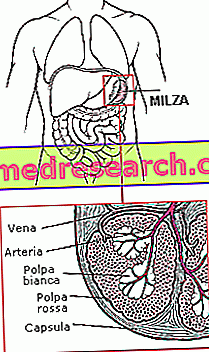What is the Spleen
The spleen is an unequal egg-shaped organ, located on the left side of the abdomen, below the diaphragm, near the stomach and pancreas. Its job is to produce white blood cells, clean blood from aged red blood cells and check for pathogens and foreign particles.

Despite being endowed with multiple functions, many of which revealed in recent times, the spleen is not an indispensable organ for life; despite this, the dogma for which, in the event of removal, other organs or systems (primarily the liver and bone marrow in the first place) can completely compensate for its functions is no longer considered valid.
Anatomy
The spleen is an organ with a high blood content, the spraying of which is entrusted to the splenic artery, while the blood outflow occurs through the splenic vein (afferent to the portal vein). The organ can therefore be considered as a large filter that, unlike the renal one (able to sift ions and small molecules), eliminates harmful or excess cells and macromolecules.
| Anatomical features | |
| Length | 12 cm |
| Width | 8 cm |
| Thickness | 3 cm |
| Medium weight | 202 g in the male, 168 in the female |
| The weight and volume of the spleen decrease with old age, while they increase during particular cardio-vascular or infectious pathologies (such as mononucleosis). | |
Functions
Let's see in detail what is the physiological role of the spleen:
- maturation of the elements of the red series: in the spleen the reticulocyte maturation and modeling (recently formed red blood cells) is completed.
- Hematopoieitica function (blood cell synthesis, typical of fetal life, can be reactivated even in the adult in case of emergency, for example after heavy bleeding).
- Macrophages in the spleen remove aged or malfunctioning red blood cells from the bloodstream; this function, both quantitative and qualitative, is called hemocateresis and is also extended to lymphocytes and platelets.
- Lymphopoieitca function (aimed at the production of white blood cells), and antibody-producing (synthesis of IgM and IgG2 antibodies). The spleen therefore has a primary immune role and contributes to increasing the body's defenses.
- Opsonine synthesis (macromolecules that facilitate the "labeling" macrophage activity and signaling certain foreign substances, otherwise difficult to recognize by the immune system, as harmful).
- It acts as a "reservoir" of blood, which the body can draw upon in case of need. This function becomes important only in pathological conditions (splenomegaly). Iron, platelets and some lymphocyte populations are also deposited in the spleen.
Diseases of the Spleen
Consequences of splenectomy
Because of all these tasks that the spleen is in charge of, patients who have undergone removal (splenectomy) have higher levels of reticulocytes, platelets and incomplete or pathological red blood cells; due to the lack of immunological functions, they are also more sensitive to infections, especially those produced by capsulated microorganisms.
The recent re-evaluation of the important role played by the spleen in the defense of the organism, especially in the pediatric age, has modified the therapeutic approach, which today is oriented above all towards a conservative treatment.
Asplenia and supernumerary spleens
Congenital absence of the spleen is a very rare anomaly, while about one person in ten has one or more accessory spleens.
Hypersplenism and Splenomeaglia
When this organ "works too much" and some of its activities are exacerbated it is called hypersplenism.
The hypersplenic syndrome manifests itself with anemia, leukopenia (few white blood cells), thrombocytopenia (few platelets) and almost always with splenomegaly (organ enlargement).
In the presence of a blood increase, the spleen increases in size (splenomegaly = enlarged spleen ) and can hold up to two liters of blood. This condition can be linked to changes in the internal blood flow (hypotonia of the intrasplenic arterial district) or to obstacles that prevent its exit (as it occurs in case of portal hypertension resulting from liver cirrhosis).
The spleen appears swollen also in the case of hemolytic diseases, when it accumulates excessive amounts of glucose or lipids (thesaurismosis) or due to neoplastic processes, however rare. Finally, splenomegaly is also typical of some infectious and parasitic diseases (toxoplasmosis, mononucleosis, hepatitis, endocarditis, typhoid, syphilis and malaria).
Spleen Rupture
The most serious complication is the rupture of the spleen, which can occur following a traumatic event but, given the greater susceptibility given by the distension of the organ, it can also arise spontaneously or with the concurrence of minimal traumas (cough, sneeze, vomiting or exertion during defecation); manifests with intense pain and hypovolemic shock. If it is not treated in time the spleen rupture can be fatal.
Spleen pain
The pain in the spleen, as well as in the aforementioned pathological conditions, can also arise following prolonged physical effort. The most plausible hypothesis in this regard is that the pain is linked to transient splenic ischemia, linked to the temporary diverting of blood from the spleen to the muscles in activity. There is therefore a thread of truth in the claims of those who maintain that spleen pain is caused by its ability to contract to let an extra number of red blood cells enter the circulation; however it must be pointed out that this function, very important for some animals, in humans is limited by the reduced capacity and contractility of the spleen.
Whatever the "benign" origin of this pain perceived during exertion, training produces circulatory and metabolic adaptations that, in the vast majority of cases, lead to the complete disappearance of the disorder.



